Mybatis
环境:
-
JDK1.8
-
Mysql 5.7 8.0
-
maven 3.6.1
-
IDEA
回顾:
-
JDBC
-
Mysql
-
Java基础
-
Maven
-
Junit
SSM框架:都是有配置文件的。最好的方式:看官方文档;
1、简介
1.1、什么是Mybatis

-
MyBatis 是一款优秀的持久层框架。
-
它支持自定义 SQL、存储过程以及高级映射。
-
MyBatis 免除了几乎所有的 JDBC 代码以及设置参数和获取结果集。
-
MyBatis 可以通过简单的 XML 或注解来配置和映射原始类型、接口和 Java POJO(Plain Old Java Objects,普通老式 Java 对象)为数据库中的记录。
-
MyBatis本是apache的一个iBatis,2010年这个由apache software foundation迁移到了,并且改名为MyBatis。
-
2013年11月迁移到。
如何获得Mybatis?
-
maven仓库:
<!-- https://mvnrepository.com/artifact/org.mybatis/mybatis --> <dependency> <groupId>org.mybatis</groupId> <artifactId>mybatis</artifactId> <version>3.5.9</version> </dependency>
1.2、持久化
数据持久化
-
持久化就是将数据在持久状态和瞬时状态转换的过程
-
内存:断电即失
-
数据库(jdbc),io文件持久化。
-
生活:冷藏、罐头。
为什么需要持久化?
-
有一些对象,不能让他丢掉。例:支付宝的钱如果丢了,你不得打死他!
-
内存太贵了
1.3、持久层
Dao层,Service层,Controller层….
-
完成持久化工作的代码块。
-
界限十分明显。
1.4、为什么需要Mybatis?
-
帮助程序猿将数据存入到数据库中。
-
方便
-
传统打的 JDBC代码太复杂了。简化。框架。自动化。
-
不用Mybatis也可以。更容易上手。技术没有高低之分
-
优点:
-
简单易学
-
灵活:mybatis不会对应用程序或者数据库的现有设计强加任何影响。 sql写在xml里,便于统一管理和优化。通过sql语句可以满足操作数据库的所有需求。
-
sql和代码的分离,提高了可维护性。
-
提供映射标签,支持对象与数据库的orm字段关系映射。
-
提供对象关系映射标签,支持对象关系组建维护。
-
提供xml标签,支持编写动态sql。
-
最重要的一点:使用的人多!
Spring、SpringMVC、SpringBoot、SpringCloud!
2、第一个Mybatis程序
思路:搭建环境- - >导入Mybatis- - >编写测试代码- - >测试!
2.1、搭建环境
搭建数据库
CREATE DATABASE `mybatis`;
USE `mybatis`;
CREATE TABLE `user`(
`id` INT(20) NOT NULL PRIMARY KEY,
`name` VARCHAR(30) DEFAULT NULL,
`pwd` VARCHAR(30) DEFAULT NULL
)ENGINE=INNODB DEFAULT CHARSET=utf8;
INSERT INTO `user`(`id`,`name`,`pwd`)VALUES
(1,'狂神','123456'),
(2,'张三','123456'),
(3,'秦疆','111111')
新建项目
-
新建一个普通的maven项目
-
删除src目录
-
导入maven依赖
<?xml version="1.0" encoding="UTF-8"?>
<project xmlns="http://maven.apache.org/POM/4.0.0"
xmlns:xsi="http://www.w3.org/2001/XMLSchema-instance"
xsi:schemaLocation="http://maven.apache.org/POM/4.0.0 http://maven.apache.org/xsd/maven-4.0.0.xsd">
<modelVersion>4.0.0</modelVersion>
<!--父工程-->
<groupId>org.example</groupId>
<artifactId>Mybatis-Study</artifactId>
<version>1.0-SNAPSHOT</version>
<!--导入依赖-->
<dependencies>
<!--mysql驱动-->
<dependency>
<groupId>mysql</groupId>
<artifactId>mysql-connector-java</artifactId>
<version>8.0.27</version>
</dependency>
<!--mybatis-->
<!-- https://mvnrepository.com/artifact/org.mybatis/mybatis -->
<dependency>
<groupId>org.mybatis</groupId>
<artifactId>mybatis</artifactId>
<version>3.5.9</version>
</dependency>
<!--junit-->
<dependency>
<groupId>junit</groupId>
<artifactId>junit</artifactId>
<version>4.12</version>
</dependency>
</dependencies>
</project>
2.2、搭建一个模块
-
编写mybatis核心配置文件
<?xml version="1.0" encoding="UTF-8" ?>
<!DOCTYPE configuration
PUBLIC "-//mybatis.org//DTD Config 3.0//EN"
"http://mybatis.org/dtd/mybatis-3-config.dtd">
<!--核心配置文件-->
<configuration>
<!--environments 环境配置-->
<environments default="development">
<environment id="development">
<transactionManager type="JDBC"/><!--transactionManager 事务管理-->
<dataSource type="POOLED">
<property name="driver" value="com.mysql.cj.jdbc.Driver"/>
<property name="url" value="jdbc:mysql://localhost:3306/mybatis?useSSL=true&useUnicode=true&characterEncoding=UTF-8"/>
<property name="username" value="root"/>
<property name="password" value="123456"/>
</dataSource>
</environment>
</environments>
</configuration>-
编写mybatis工具类
package com.kuang.utils; import org.apache.ibatis.io.Resources; import org.apache.ibatis.session.SqlSession; import org.apache.ibatis.session.SqlSessionFactory; import org.apache.ibatis.session.SqlSessionFactoryBuilder; import java.io.IOException; import java.io.InputStream; //sqlSessionFactory -- > sqlSession public class MybatisUtils { private static SqlSessionFactory sqlSessionFactory;//在这里提升了 static { //使用 Mybatis第一步: 获取 sqlSessionFactory对象 try { String resource = "mybatis-config.xml"; InputStream inputStream = Resources.getResourceAsStream(resource); sqlSessionFactory = new SqlSessionFactoryBuilder().build(inputStream); } catch (IOException e) { e.printStackTrace(); } } //既然有了 SqlSessionFactory,顾名思义,我们可以从中获得 SqlSession 的实例。 // SqlSession 提供了在数据库执行 SQL 命令所需的所有方法。 public static SqlSession getSqlSession(){ return sqlSessionFactory.openSession();//优化 //SqlSession sqlSession = sqlSessionFactory.openSession();//这里要拿到 sqlSessionFactory,所以提升作用域 //return sqlSession; } }
2.3、编写代码
-
实体类
package com.kuang.pojo;
public class User {
private int id;
private String name;
private String pwd;
public User() {
}
public User(int id, String name, String pwd) {
this.id = id;
this.name = name;
this.pwd = pwd;
}
public int getId() {
return id;
}
public void setId(int id) {
this.id = id;
}
public String getName() {
return name;
}
public void setName(String name) {
this.name = name;
}
public String getPwd() {
return pwd;
}
public void setPwd(String pwd) {
this.pwd = pwd;
}
@Override
public String toString() {
return "User{" +
"id=" + id +
", name='" + name + '\'' +
", pwd='" + pwd + '\'' +
'}';
}
}-
Dao接口
public interface UserDao {
List<User> getUserList();
}-
接口实现类由原来的UserMapperImpl转换为Mapper配置文件
<?xml version="1.0" encoding="UTF-8" ?>
<!DOCTYPE mapper
PUBLIC "-//mybatis.org//DTD Mapper 3.0//EN"
"http://mybatis.org/dtd/mybatis-3-mapper.dtd">
<!--namespace= 绑定一个对应的Dao/Mapper接口 -->
<mapper namespace="com.kuang.dao.UserDao">
<!--select 查询语句-->
<select id="getUserList" resultType="com.kuang.pojo.User">
select * from mybatis.user
</select>
</mapper>
2.4、测试
注意点:
org.apache.ibatis.binding.BindingException: Type interface com.kuang.dao.UserDao is not known to the MapperRegistry.
MapperRegistry是什么?
出现这个就代表没有注册mappers
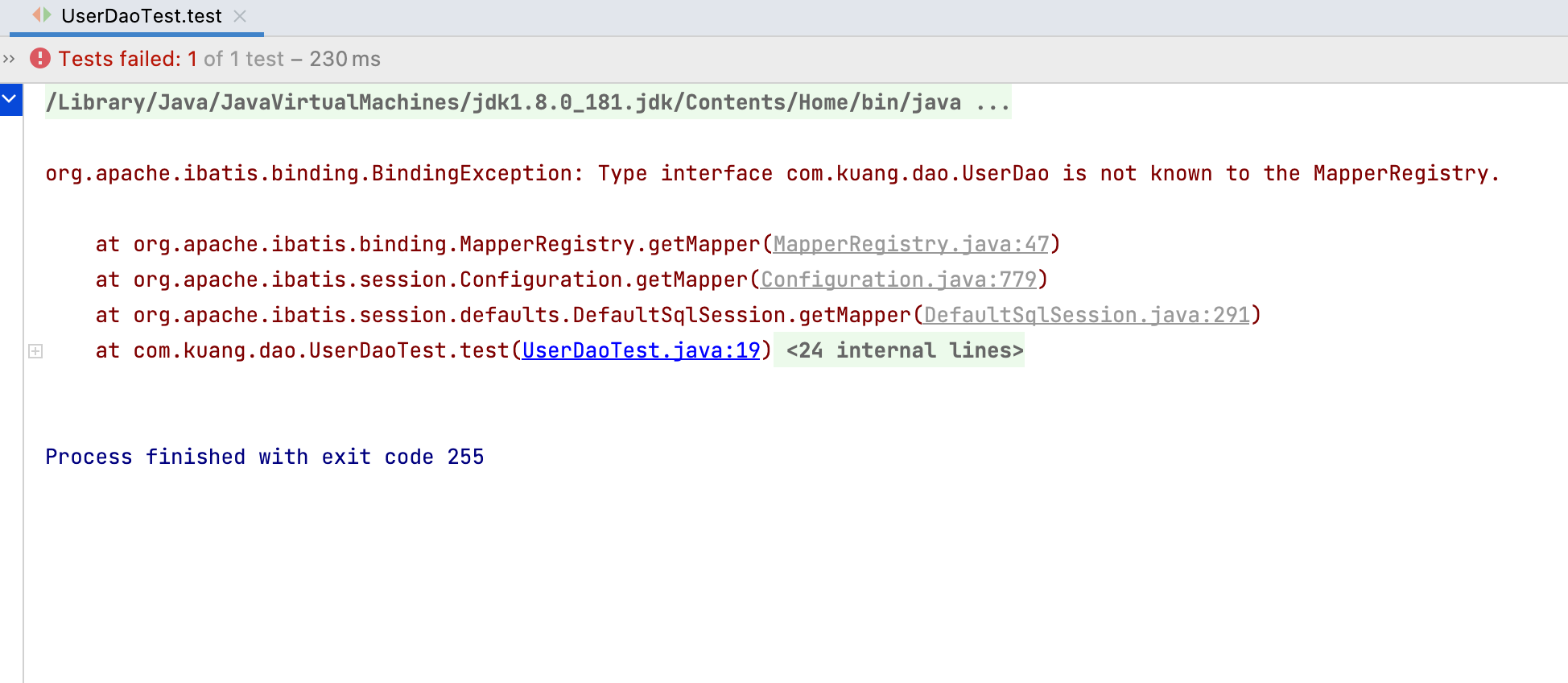
<mappers>
<mapper resource="com/kuang/dao/UserMapper.xml"/>
</mappers>-
junit测试:
package com.kuang.dao;
import com.kuang.pojo.User;
import com.kuang.utils.MybatisUtils;
import org.apache.ibatis.session.SqlSession;
import org.junit.Test;
import java.util.List;
public class UserDaoTest {
@Test
public void test(){
//第一步:获取 SqlSession
SqlSession sqlSession = MybatisUtils.getSqlSession();
//方式一:getMapper
UserDao mapper = sqlSession.getMapper(UserDao.class);
List<User> userList = mapper.getUserList();
for (User user : userList) {
System.out.println(user);
}
//关闭sqlSession
sqlSession.close();
}
}程序的步骤:

你们可能会遇到的问题:
1.配置文件没有注册
2.绑定接口错误
3.方法名不对
4.返回类型不对
5.Maven导出资源问题
还有错误看下面看看是否有你的问题:
初始化异常失败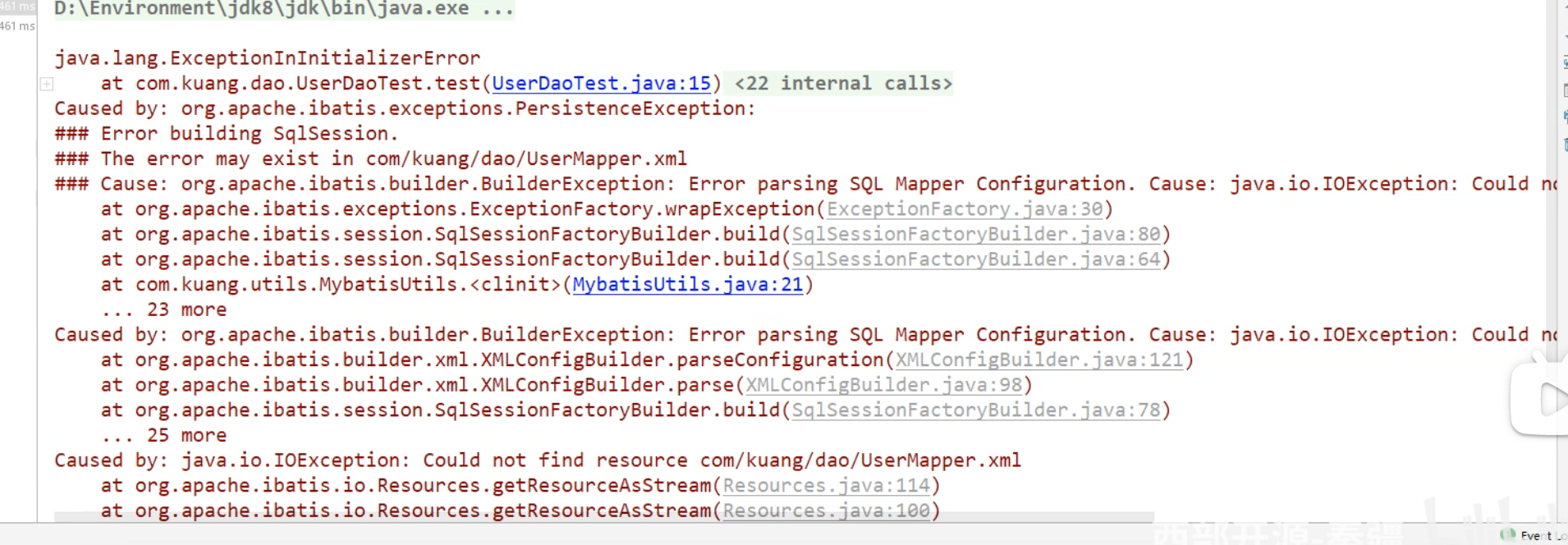
出现这个你会发现你明明写了呀,但是就是不存在!你可以把UserMapper.xml放在target中对应的目录中就可以正常运行,所以这里就会出现一个问题,约定大于配置!
<build>
<resources>
<resource>
<directory>src/main/java</directory>
<includes>
<include>**/*.properties</include>
<include>**/*.xml</include>
</includes>
<filtering>false</filtering>
</resource>
<resource>
<directory>src/main/resources</directory>
<includes>
<include>**/*.properties</include>
<include>**/*.xml</include>
</includes>
<filtering>false</filtering>
</resource>
</resources>
</build>
而且你可能还会遇到的问题,这里我的运行时出现了Could not find resource mybatis-config.xml(找不到 xxx.xml)
如果出现了这个问题:请看这个博客:https://blog.csdn.net/qq_38589743/article/details/110263936,可以解决你的需求!
3、CRUD
在这里有的小伙伴可能会遇到一个问题就是为什么idea连接了数据库但是没有提示:
https://blog.csdn.net/qq_39510043/article/details/107978717可以看看这个,可以帮助你!
1、namespace
namespace中的包名要和 Dao/Mapper 接口的包名一直!
2、select
选择,查询语句:
-
id:就是对应的namespace中的方法名;
-
resultType:sql语句执行的返回值!
-
parameterType:参数类型!
-
编写接口
//查询全部用户 List<User> getUserList(); //根据ID查询用户 User getUserById(int id); -
编写对应的mapper中的sql语句
<!--select 查询语句-->
<select id="getUserList" resultType="com.kuang.pojo.User">
select * from mybatis.user;
</select>
<select id="getUserById" parameterType="int" resultType="com.kuang.pojo.User">
select * from mybatis.user where id = #{id};
</select>3、测试
@Test
public void test(){
//第一步:获取 SqlSession
SqlSession sqlSession = MybatisUtils.getSqlSession();
//方式一:getMapper
UserMapper mapper = sqlSession.getMapper(UserMapper.class);
List<User> userList = mapper.getUserList();
//方式二:不推荐使用!
//List<User> userList = sqlSession.selectList("com.kuang.dao.UserDao.getUserList");
for (User user : userList) {
System.out.println(user);
}
//关闭sqlSession
sqlSession.close();
}
@Test
public void getUserById(){
SqlSession sqlSession = MybatisUtils.getSqlSession();
UserMapper mapper = sqlSession.getMapper(UserMapper.class);
User user = mapper.getUserById(1);
System.out.println(user);
sqlSession.close();
}3、Insert
1、编写接口
//insert一个用户
int addUser(User user);2、编写mapper对应的sql
<insert id="addUser" parameterType="com.kuang.pojo.User">
insert into mybatis.user (id, name, pwd) VALUES (#{id},#{name},#{pwd});
</insert>3、测试
//增删改需要提交事务!
@Test
public void addUser(){
SqlSession sqlSession = MybatisUtils.getSqlSession();
UserMapper mapper = sqlSession.getMapper(UserMapper.class);
int i = mapper.addUser(new User(4, "桐人", "111222"));
if (i > 0){
System.out.println("插入成功!");
}
//提交事务!
sqlSession.commit();
sqlSession.close();
}4、update
1、接口
//修改用户
int updateUser(User user);2、sql
<update id="updateUser" parameterType="com.kuang.pojo.User">
update mybatis.user set name=#{name} ,pwd=#{pwd} where id=#{id};
</update>3、测试
@Test
public void updateUser(){
SqlSession sqlSession = MybatisUtils.getSqlSession();
UserMapper mapper = sqlSession.getMapper(UserMapper.class);
mapper.updateUser(new User(4,"桐人","123456"));
sqlSession.commit();
sqlSession.close();;
}5、Delete
1、接口
//删除用户
int deleteUser(int id);2、sql
<delete id="deleteUser" parameterType="int">
delete from mybatis.user where id=#{id};
</delete>3、测试
@Test
public void deleteUser(){
SqlSession sqlSession = MybatisUtils.getSqlSession();
UserMapper mapper = sqlSession.getMapper(UserMapper.class);
mapper.deleteUser(4);
sqlSession.commit();
sqlSession.close();
}
注意点:
-
增删改需要提交事务!
6、分析错误
-
标签不要匹配错
-
resource 绑定 mapper,需要使用路径!
-
程序配置文件必须规范!
-
NullPointerException,没有注册到资源!
-
输出的xml文件中存在乱码!
-
maven资源没有导出问题!
7、万能的Map
假设,我们的实体类,或者数据库中的表、字段或者参数过多,我们应当考虑使用Map!
//万能的map
int addUser2(Map<String,Object> map); <!--对象中的属性可以直接取出来 传递map的key-->
<insert id="addUser2" parameterType="map">
insert into mybatis.user (id, name, pwd) VALUES (#{userid},#{userName},#{password});
</insert> @Test
public void addUser2(){
SqlSession sqlSession = MybatisUtils.getSqlSession();
UserMapper mapper = sqlSession.getMapper(UserMapper.class);
Map<String, Object> map = new HashMap<String, Object>();
map.put("userid",5);
map.put("userName","krito");
map.put("password","2333333");
mapper.addUser2(map);
//提交事务!
sqlSession.commit();
sqlSession.close();
}
Map传递参数,直接在sql中取出key即可! 【parameterType="map"】
对象传递参数,直接在SQL中取出对象的属性即可! 【parameterType="Object"】
只有一个基本类型参数的情况下,可以直接在sql中取到!
多个参数用Map,或者注解!
8、思考题
模糊查询怎么写?
1、java代码执行的时候,传递通配符% %
List<User> userList = mapper.getUserLike("%李%");2、在sql拼接中使用通配符!
select * from mybatis.user where name like "%"#{value}"%" 注意点:
<!--
select * from mybatis.user where id = ?
select * from mybatis.user where id = 1 or 1=1
-->
<select id="getUserLike" resultType="com.kuang.pojo.User">
select * from mybatis.user where name like concat(concat('%',#{value}),'%')
</select>
4、配置解析
4.1、核心配置文件
-
mybatis.config.xml
-
MyBatis 的配置文件包含了会深深影响 MyBatis 行为的设置和属性信息。
configuration(配置)
properties(属性)
settings(设置)
typeAliases(类型别名)
typeHandlers(类型处理器)
objectFactory(对象工厂)
plugins(插件)
environments(环境配置)
environment(环境变量)
transactionManager(事务管理器)
dataSource(数据源)
databaseIdProvider(数据库厂商标识)
mappers(映射器)
4.2、配置环境(environments)
Mybatis可以配置成适应多种环境
不过要记住:尽管可以配置多个环境,但每个 SqlSessionFactory 实例只能选择一种环境!
学会使用配置多套运行环境!
Mybatis默认的事务管理器是 JDBC,连接池:POOLED
4.3、properties(属性)
我们可以通过properties属性来实现引用配置文件
这些属性可以在外部进行配置,并可以进行动态替换。你既可以在典型的 Java 属性文件中配置这些属性,也可以在 properties 元素的子元素中设置。【db.properties】

编写一个配置文件
db.properties
driver=com.mysql.jdbc.Driver
url=jdbc:mysql://localhost:3306/mybatis?useSSL=true&useUnicode=true&characterEncoding=UTF-8
username=root
password=mysqlstart在核心配置文件中引入
<!--引入外部配置文件-->
<properties resource="db.properties">
<property name="username" value="root"/>
<property name="password" value="mysqlstart"/>
</properties>-
可以直接引入外部文件
-
可以在其中添加一些属性配置
-
如果两个文件有同一个字段,优先使用外部配置文件的!
4.4、类型别名(typeAliases)
-
类型别名可为 Java 类型设置一个缩写名字。
-
它仅用于 XML 配置,意在降低冗余的全限定类名书写。
<!--可以给实体类起别名-->
<typeAliases>
<typeAlias type="com.kuang.pojo.User" alias="User"/>
</typeAliases>也可以指定一个包名,MyBatis 会在包名下面搜索需要的 Java Bean,比如:
扫描实体类的包,它的默认别名就是为这个类的类名,首字母小写!
<!--可以给实体类起别名-->
<typeAliases>
<package name="com.kuang.pojo"/>
</typeAliases>
在实体类比较少的时候,使用第一种方式。
如果实体类十分多,建议使用第二种。
第一种可以DIY别名,第二种则 不行 ,如果非要改,需要在实体类上增加注解
@Alias("user")
public class User {}
4.5、设置
这是Mybatis 中极其重要的调整设置,他们会改变Mybatis的运行时行为。


4.6、其他设置
-
typeHandlers(类型处理器)
-
objectFactory(对象工厂)
-
plugins(插件)
-
mybatis-generator-core
-
mybatis-plus
-
通用mapper
-
4.7、映射器(mappers)
MapperRegistry:注册绑定我们的mapper文件;
方式一:【推荐使用】
<!--每一个Mapper.xml都需要在Mybatis核心配置文件中注册!-->
<mappers>
<mapper resource="com/kuang/dao/UserMapper.xml"/>
</mappers>方式二:使用class文件绑定注册
<!--每一个Mapper.xml都需要在Mybatis核心配置文件中注册!-->
<mappers>
<mapper class="com.kuang.dao.UserMapper"/>
</mappers>
注意点:
-
接口和他的Mapper配置文件必须同名!
-
接口和他的Mapper配置文件必须在同一个包下!
方式三:使用扫描包进行注入绑定
<!--每一个Mapper.xml都需要在Mybatis核心配置文件中注册!-->
<mappers>
<package name="com.kuang.dao"/>
</mappers>
注意点:
-
接口和他的Mapper配置文件必须同名!
-
接口和他的Mapper配置文件必须在同一个包下!
练习:
-
将数据库配置文件导入
-
实体类别名
-
保证UserMapper 接口 和UserMapper.xml 改为一致!并且放在同一个包下!
4.8、生命周期和作用域
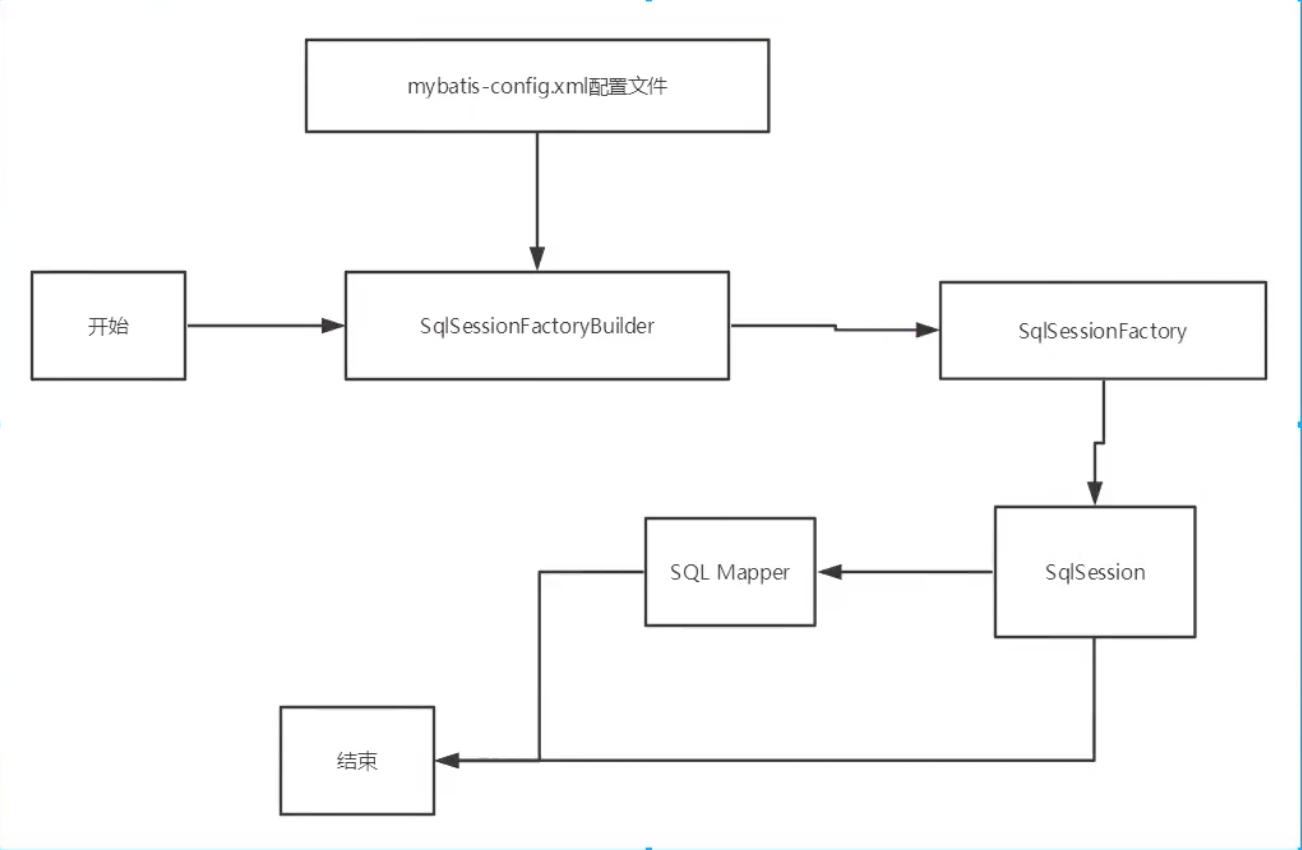
不同作用域和生命周期类别是至关重要的,因为错误的使用会导致非常严重的并发问题。
SqlSessionFactoryBuilder
-
一旦创建了 SqlSessionFactory,就不需要它了
-
局部变量
SqlSessionFactory
-
说白了就是可以想象为:数据库连接池
-
SqlSessionFactory 一旦被创建就应该在应用的运行期间一直存在,没有任何理由丢弃它或重新创建另一个实例。
-
SqlSessionFactory 的最佳作用域是应用作用域。
-
最简单的就是使用单例模式或者静态单例模式。
SqlSession
-
连接到连接池的一个请求!
-
SqlSession 的实例不是线程安全的,因此是不能被共享的,所以它的最佳的作用域是请求或方法作用域。
-
用完之后需要赶紧关闭,否则资源被占用!
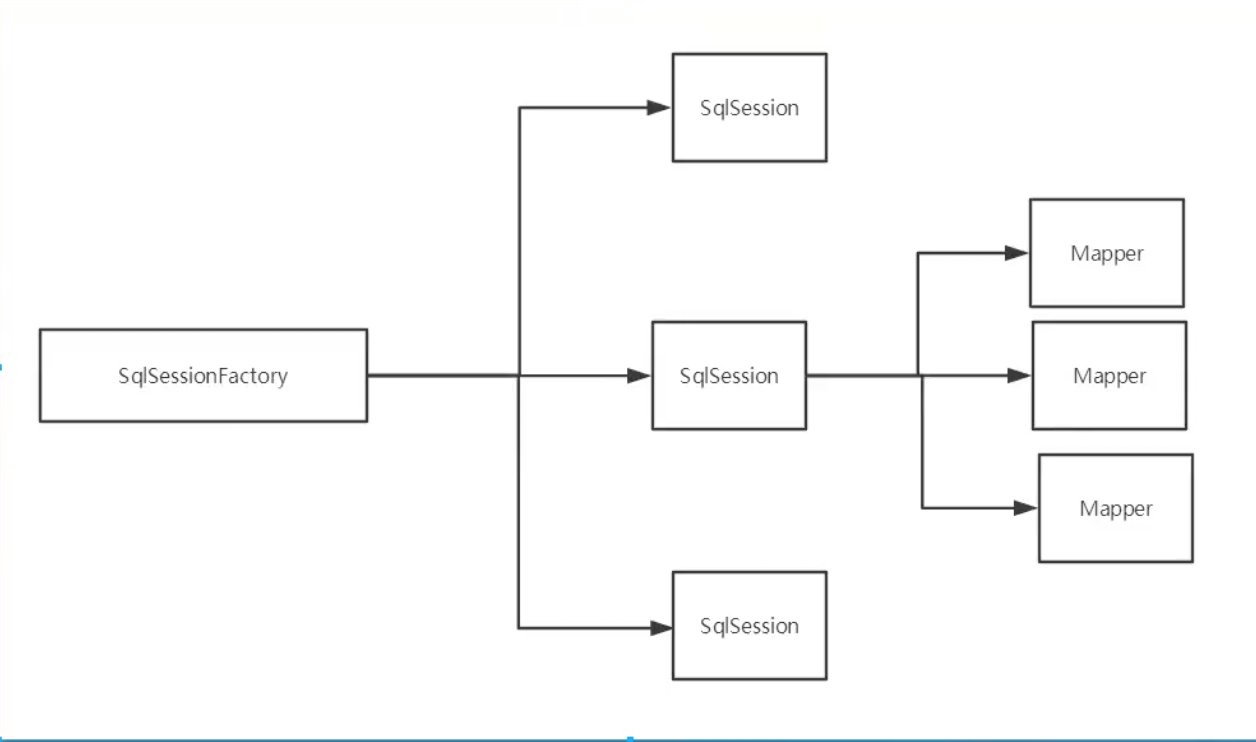
这里的每一个mapper,都代表一个具体的业务!
5、解决属性名和字段名不一致的问题
5.1、问题
数据库中的字段
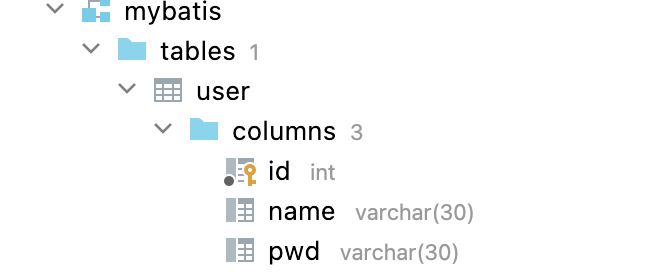
新建一个项目,拷贝之前的,测试实体类字段不一致的情况
public class User {
private int id;
private String name;
private String password;
}测试出现问题
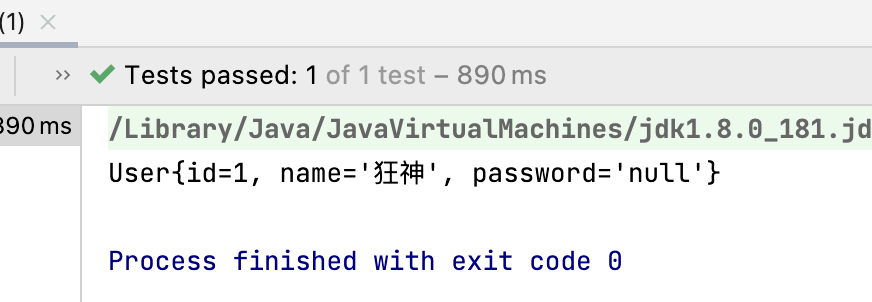
// select * from mybatis.user where id = #{id};
// select id,name,pwd from mybatis.user where id = #{id};
解决方法:
-
起别名
<select id="getUserById" parameterType="int" resultType="com.kuang.pojo.User">
select id,name,pwd as password from mybatis.user where id = #{id};
</select>
2、ResultMap
结果集映射
id name pwd
id name password <!--结果集映射-->
<resultMap id="UserMap" type="User">
<!--column数据库中的字段,property实体类中的属性 ,前两个数据库字段与实体类相同可以不写-->
<!-- <result column="id" property="id"/>-->
<!-- <result column="name" property="name"/>-->
<result column="pwd" property="password"/>
</resultMap>
<select id="getUserById" resultMap="UserMap">
select * from mybatis.user where id = #{id};
</select>
-
resultMap元素是 MyBatis 中最重要最强大的元素。 -
resultMap 的设计思想是,对简单的语句做到零配置,对于复杂一点的语句,只需要描述语句之间的关系就行了。
-
ResultMap的优秀之处——你完全可以不用显式地配置它们。 -
如果这个世界总是这么简单就好了。
6、日志
6.1、日志工厂
如果一个数据库操作,出现了异常,我们就需要排错。日志就是我们最好的助手!
曾经:sout、debug

-
SLF4J
-
LOG4J 【掌握】
-
LOG4J2
-
JDK_LOGGING
-
COMMONS_LOGGING
-
STDOUT_LOGGING 【掌握】
-
NO_LOGGING
在Mybatis中具体使用哪一个日志实现,在设置中设定!
STDOUT_LOGGING 标准日志输出
在Mybatis核心配置文件中,配置我们的日志!
<settings>
<!--标准的日志工厂实现-->
<setting name="logImpl" value="STDOUT_LOGGING"/>
</settings>
6.2、Log4J
什么是Log4j?
-
Log4j是的一个开源项目,通过使用Log4j,我们可以控制日志信息输送的目的地是、文件、组件
-
我们也可以控制每一条日志的输出格式
-
通过定义每一条日志信息的级别,我们能够更加细致地控制日志的生成过程。
-
通过一个来灵活地进行配置,而不需要修改应用的代码。
1.导入log4J的包
<!-- https://mvnrepository.com/artifact/log4j/log4j -->
<dependency>
<groupId>log4j</groupId>
<artifactId>log4j</artifactId>
<version>1.2.17</version>
</dependency>2.log4j.properties
#将等级为DEBUG的日志信息输出到console和file这两个目的地,console和file的定义在下面的代码
log4j.rootLogger=DEBUG,console,file
#控制台输出的相关设置
log4j.appender.console = org.apache.log4j.ConsoleAppender
log4j.appender.console.Target = System.out
log4j.appender.console.Threshold=DEBUG
log4j.appender.console.layout = org.apache.log4j.PatternLayout
log4j.appender.console.layout.ConversionPattern=【%c】-%m%n
#文件输出的相关设置
log4j.appender.file = org.apache.log4j.RollingFileAppender
log4j.appender.file.File=./log/kuang.log
log4j.appender.file.MaxFileSize=10mb
log4j.appender.file.Threshold=DEBUG
log4j.appender.file.layout=org.apache.log4j.PatternLayout
log4j.appender.file.layout.ConversionPattern=【%p】【%d{yy-MM-dd}】【%c】%m%n
#日志输出级别
log4j.logger.org.mybatis=DEBUG
log4j.logger.java.sql=DEBUG
log4j.logger.java.sql.Statement=DEBUG
log4j.logger.java.sql.ResultSet=DEBUG
log4j.logger.java.sql.PreparedStatement=DEBUG3.配置log4j为日志实现
<settings>
<setting name="logImpl" value="LOG4J"/>
</settings>4.Log4j的使用!直接测试运行刚才的查询
简单使用
-
在要使用log4j的类中,导入包 import org.apache.log4j.Logger;
-
日志对象,参数为当前类的class
static Logger logger = Logger.getLogger("UserMapperTest"); -
日志级别
logger.info("info:进入了testLog4j");
logger.debug("debug:进入了testLog4j");
logger.error("error:进入了testLog4j");
案例:
package com.kuang.dao;
import com.kuang.pojo.User;
import com.kuang.utils.MybatisUtils;
import org.apache.ibatis.session.SqlSession;
import org.apache.log4j.Logger;
import org.junit.Test;
public class UserMapperTest {
static Logger logger = Logger.getLogger("UserMapperTest");
@Test
public void testgetUserLike(){
//第一步:获取 SqlSession
SqlSession sqlSession = MybatisUtils.getSqlSession();
logger.info("测试,进入testgetUserLike,成功!");//在这里写一个提示信息
//方式一:getMapper
UserMapper mapper = sqlSession.getMapper(UserMapper.class);
User userList = mapper.getUserById(1);
System.out.println(userList);
//关闭sqlSession
sqlSession.close();
}
}
7、分页
思考:为什么要分页?
-
减少数据的处理量
7.1、使用limit分页
语法:SELECT * from user limit startIndex,pageSize;
select * from user limit 3 #[0,n]
使用Mybatis实现分页,核心SQL
-
接口
//分页 List<User> getUserByLimit(Map<String,Integer> map); -
Mapper.xml
<select id="getUserByLimit" parameterType="map" resultMap="UserMap"> select * from mybatis.user limit #{startIndex} ,#{pageSize}; </select> -
测试
@Test
public void getUserByLimit(){
SqlSession sqlSession = MybatisUtils.getSqlSession();
UserMapper mapper = sqlSession.getMapper(UserMapper.class);
HashMap<String, Integer> map = new HashMap<>();
map.put("startIndex",0);
map.put("pageSize",2);
List<User> userList = mapper.getUserByLimit(map);
for (User user : userList) {
System.out.println(user);
}
sqlSession.close();
}
7.2、RowBounds分页
不再使用SQL实现分页
-
接口
//分页2 List<User> getUserByRowBounds(); -
mapper.xml
<select id="getUserByRowBounds" resultMap="UserMap"> select * from mybatis.user </select> -
测试
@Test public void getUserByRowBounds(){ SqlSession sqlSession = MybatisUtils.getSqlSession(); //RowBounds实现 RowBounds rowBounds = new RowBounds(1,2); //通过Java代码层面实心分页 List<User> userList = sqlSession.selectList("com.kuang.dao.UserMapper.getUserByRowBounds", null,rowBounds); for (User user : userList) { System.out.println(user); } sqlSession.close(); }
7.3、分页插件
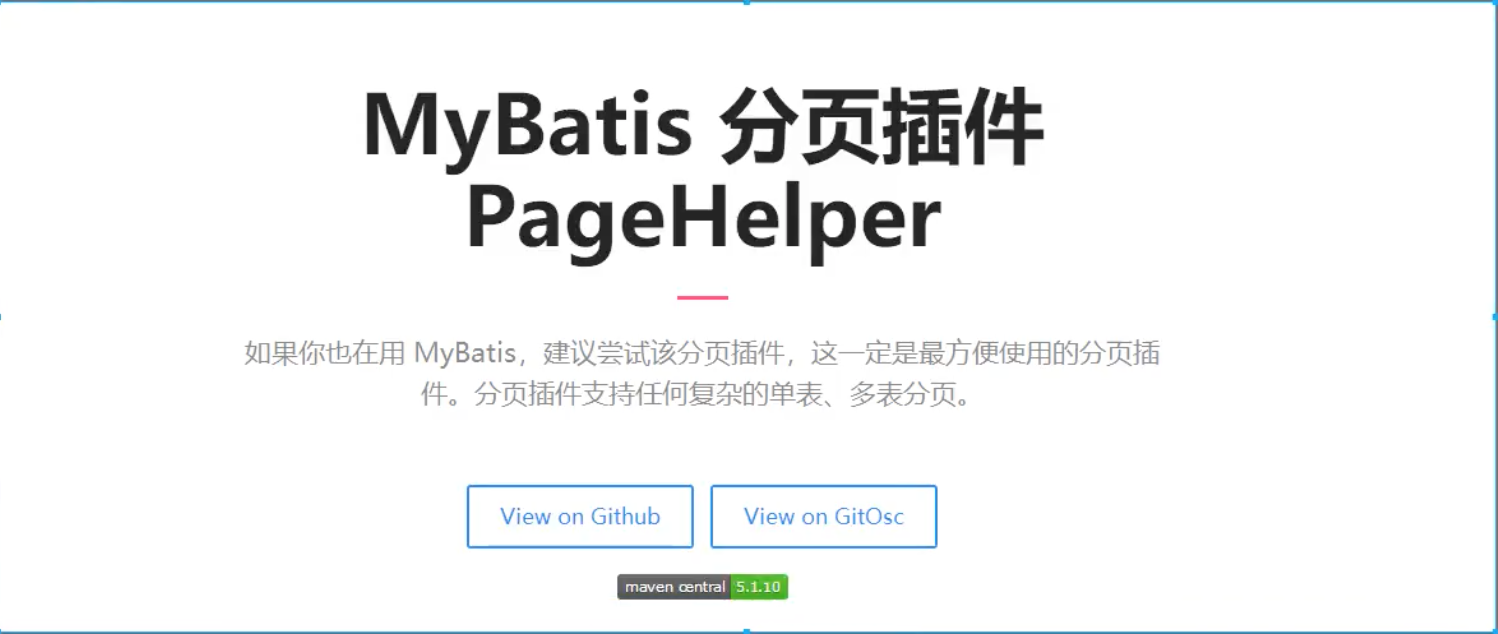
了解即可,万一以后公司的架构师,说要使用,你需要知道他是什么东西!
8、使用注解开发
8.1、面向接口编程
根本原因:解耦,可拓展,提高复用,分层开发中,上层不用管具体的实现,大家都遵守共同的标准,使得开发更容易,规范性更好!
接口的理解
接口从更深层次的理解,应是定义(规范、约束)与实现(名实分离)的分离。
接口的本质反应了系统设计人员对系统的抽象理解
分为两类:
-
第一类对一个个体的抽象,他可对应一个抽象体(abstart class)
-
第二类是对一个个体某一方面的抽象,即形成一个抽象面(interface)
一个体有可能存在多个抽象面。抽象体与抽象面是有区别的。
三个面向区别
-
面向对象是指,我们考虑问题时,以对象为单位,考虑它的属性和方法;
-
面向过程是指,我们考虑问题时,以一个具体的流程(事务过程)为单位,考虑它的实现;
-
接口设计与非接口设计是针对复用技术而言的,与面向对象(过程)不是一个问题,更多的体现就是对系统整体的架构;
8.2、使用注解开发
-
注解在接口上实现
@Select("select * from user") List<User> getUsers(); -
需要在核心配置文件中绑定接口!
<!--绑定配置文件--> <mappers> <mapper class="com.kuang.dao.UserMapper"/> </mappers> -
测试
@Test public void getUserTest(){ SqlSession sqlSession = MybatisUtils.getSqlSession(); //底层主要应用反射 UserMapper mapper = sqlSession.getMapper(UserMapper.class); List<User> users = mapper.getUsers(); for (User user : users) { System.out.println(user); } sqlSession.close(); }
本质:反射机制实现
底层:动态代理!

Mybatis详细执行流程

8.3、CRUD
我们可以在工具类创建的时候实现自动提交事务!
public static SqlSession getSqlSession(){
return sqlSessionFactory.openSession(true);
}
编写接口,增加注解
package com.kuang.dao;
import com.kuang.pojo.User;
import org.apache.ibatis.annotations.*;
import java.util.List;
public interface UserMapper {
@Select("select * from user")
List<User> getUsers();
// 方法存在多个参数,所有的参数前面必须加上 @Param("id") 注解
@Select("select * from user where id = #{id}")
User getUserByID(@Param("id")int id);
@Insert("insert into user(id,name,pwd) values (#{id},#{name},#{password})")
int addUser(User user);
@Update("update user set name = #{name},pwd=#{password} where id=#{id}")
int updateUser(User user);
@Delete("delete from user where id = #{uid}")
int deleteUser(@Param("uid")int id);
}
测试类
【注意:我们必须要将我们的接口注册绑定到我们的核心配置文件中!】
import com.kuang.dao.UserMapper;
import com.kuang.pojo.User;
import com.kuang.utils.MybatisUtils;
import org.apache.ibatis.session.SqlSession;
import org.junit.Test;
import java.util.List;
public class UserMapperTest {
@Test
public void getUserTest(){
SqlSession sqlSession = MybatisUtils.getSqlSession();
//底层主要应用反射
UserMapper mapper = sqlSession.getMapper(UserMapper.class);
mapper.deleteUser(6);
sqlSession.close();
}
/**
* List<User> users = mapper.getUsers();
* for (User user : users) {
* System.out.println(user);
* }
*
* User userByID = mapper.getUserByID(1);
*
* System.out.println(userByID);
*
* mapper.addUser(new User(4,"尤吉欧","123456"));
*
* mapper.updateUser(new User(6,"杂货","11117881"));
*/
}
关于@Param()注解
-
基本类型的参数或者String类型,需要加上
-
引用类型不需要加
-
如果只有一个基本类型的话,可以忽略,但是建议大家加上!
-
我们在SQL中引用的就是我们这里的@Param()中设定的属性名!
#{} ${} 区别
可以简单理解为 PreparedStatement 与 Statement
使用${}会有SQL注入拼接问题,所以我们使用#{}
9、Lombok
Project Lombok is a java library that automatically plugs into your editor and build tools, spicing up your java.
Never write another getter or equals method again, with one annotation your class has a fully featured builder, Automate your logging variables, and much more.-
java library
-
plugs
-
build tools
-
ith one annotation your class
使用步骤:
-
在IDEA中安装Lombok插件!
-
在项目中导入lombok的jar包
<!-- https://mvnrepository.com/artifact/org.projectlombok/lombok --> <dependency> <groupId>org.projectlombok</groupId> <artifactId>lombok</artifactId> <version>1.18.22</version> </dependency> -
在实体类上加注解
@Getter and @Setter
@FieldNameConstants
@ToString
@EqualsAndHashCode
@AllArgsConstructor, @RequiredArgsConstructor and @NoArgsConstructor
@Log, @Log4j, @Log4j2, @Slf4j, @XSlf4j, @CommonsLog, @JBossLog, @Flogger, @CustomLog
@Data
@Builder
@SuperBuilder
@Singular
@Delegate
@Value
@Accessors
@Wither
@With
@SneakyThrows
@val
@var
experimental @var
@UtilityClass
Lombok config system
Code inspections
Refactoring actions (lombok and delombok)
说明:
@Data :无参构造、get、set、tostring、hashcode、equals
@AllArgsConstructor 有参构造
@NoArgsConstructor 无参构造
@Getter and @Setter
@EqualsAndHashCode
@ToString图示:
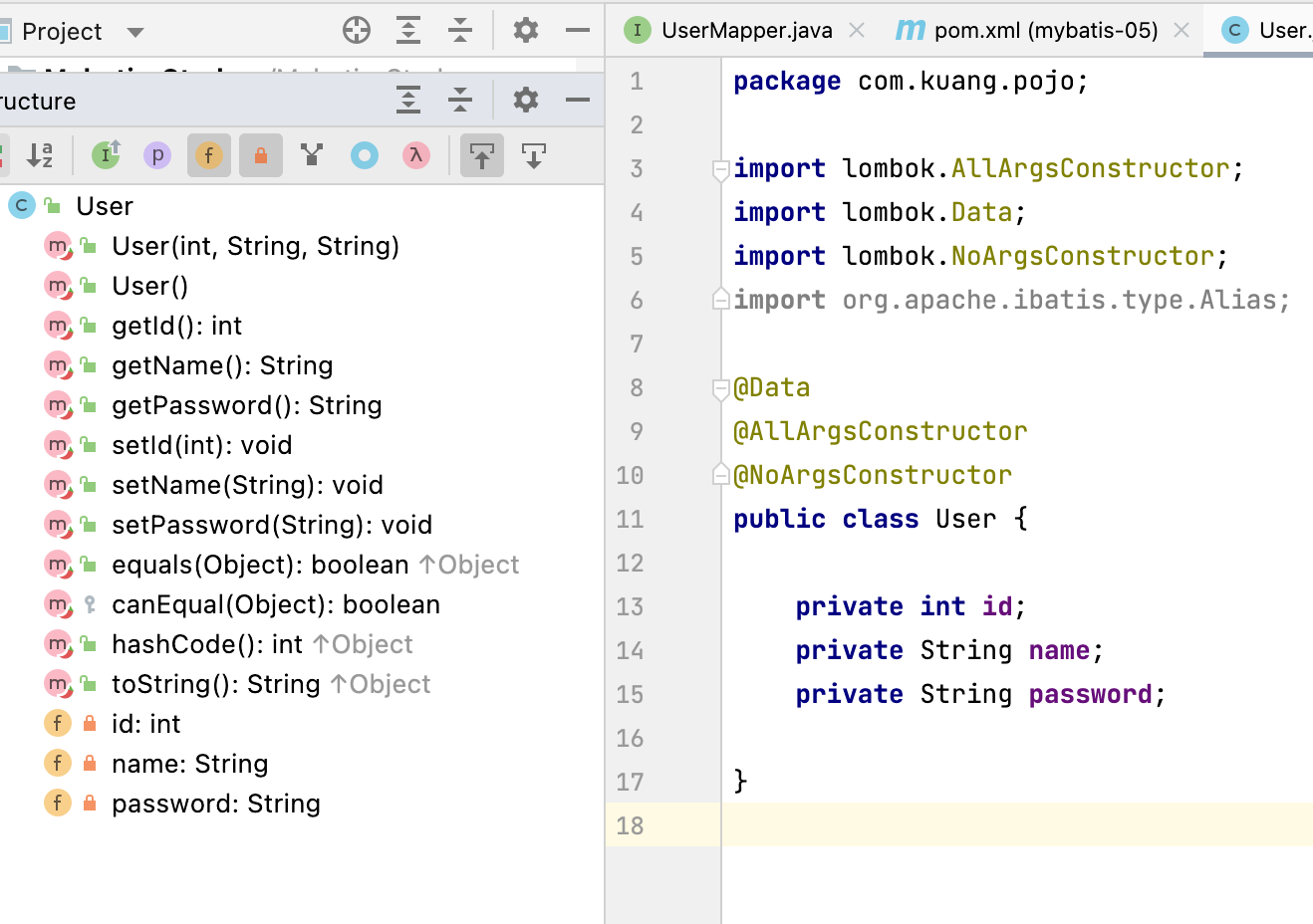
10、多对一处理
多对一:

-
多个学生对应一个老师
-
对于学生而言,关联 …多个学生,关联一个老师【多对一】
-
对于老师而言,集合,一个老师有【一对多】
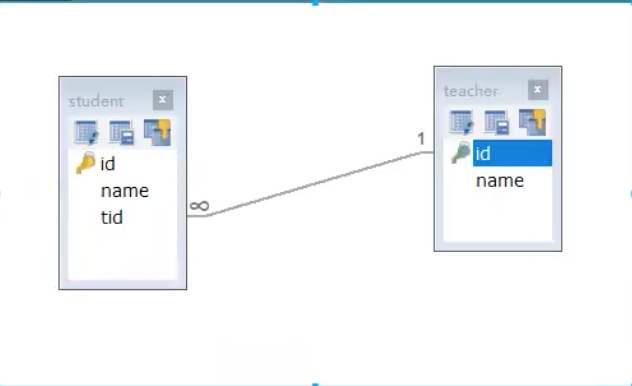
SQL:
USE mybatis
CREATE TABLE `teacher` (
`id` INT(10) NOT NULL,
`name` VARCHAR(30) DEFAULT NULL,
PRIMARY KEY (`id`)
) ENGINE=INNODB DEFAULT CHARSET=utf8
INSERT INTO teacher(`id`, `name`) VALUES (1, '秦老师');
CREATE TABLE `student` (
`id` INT(10) NOT NULL,
`name` VARCHAR(30) DEFAULT NULL,
`tid` INT(10) DEFAULT NULL,
PRIMARY KEY (`id`),
KEY `fktid` (`tid`),
CONSTRAINT `fktid` FOREIGN KEY (`tid`) REFERENCES `teacher` (`id`)
) ENGINE=INNODB DEFAULT CHARSET=utf8
INSERT INTO `student` (`id`, `name`, `tid`) VALUES ('1', '小明', '1');
INSERT INTO `student` (`id`, `name`, `tid`) VALUES ('2', '小红', '1');
INSERT INTO `student` (`id`, `name`, `tid`) VALUES ('3', '小张', '1');
INSERT INTO `student` (`id`, `name`, `tid`) VALUES ('4', '小李', '1');
INSERT INTO `student` (`id`, `name`, `tid`) VALUES ('5', '小王', '1');对于多表查询:这里字段解析:
-- constraint 外键名 foreign key 外键字段 references 主表名(关联字段) [主表记录删除时的动作] [主表记录更新时的动作]
-- constraint可以省略,只是用来指定外键名: 约束测试环境搭建
-
导入lombok
-
新建实体类 Teacher、Student
-
建立Mapper接口
-
建立Mapper.xml文件
-
在核心配置文件中绑定注册我们的Mapper接口或者文件!【方式很多,随心选】
-
测试查询是否能够成功!
按照查询嵌套处理
<!--
思路:
1.查询所有的学生信息
2.根据查询出来的学生的 tid ,寻找对应的老师! 子查询
-->
<select id="getStudent" resultMap="StudentTeacher">
select * from mybatis.student ;
</select>
<resultMap id="StudentTeacher" type="Student">
<result property="id" column="id"/>
<result property="name" column="name"/>
<!--复杂的属性,我们需要单独处理 对象:association 集合:collection -->
<association property="teacher" column="tid" javaType="Teacher" select="getTeacher"/>
</resultMap>
<select id="getTeacher" resultType="Teacher">
select * from mybatis.teacher where id = #{tid}
</select>
按照结果嵌套处理
<!--按照结果嵌套处理-->
<select id="getStudent2" resultMap="StudentTeacher2">
select s.id sid,s.name sname ,t.name tname
from mybatis.student s,mybatis.teacher t
where s.tid = t.id
</select>
<resultMap id="StudentTeacher2" type="Student">
<result property="id" column="sid"/>
<result property="name" column="sname"/>
<association property="teacher" javaType="Teacher">
<result property="name" column="tname"/>
</association>
</resultMap>
回顾MySQL 多对一查询方式:
-
子查询
-
联表查询
11、一对多处理
比如:一个老师拥有多个学生!
对于老师而言,就是一对多的关系!
环境搭建
1.环境搭建,和刚才一样
实体类
@Data
public class Student {
private int id;
private String name;
private int tid;
} @Data
public class Teacher {
private int id;
private String name;
//一个老师拥有多个学生
private List<Student> students;
}
按照结果嵌套处理
<!--按结果嵌套查询-->
<select id="getTeacher" resultMap="TeacherStudent">
select s.id sid,s.name sname,t.name tname ,t.id tid
from mybatis.teacher t,mybatis.student s
where s.tid = t.id and t.id= #{tid}
</select>
<resultMap id="TeacherStudent" type="Teacher">
<result property="id" column="tid"/>
<result property="name" column="tname"/>
<!--复杂的属性,我们需要单独处理 对象:association 集合: collection
javaType="" 指定属性的类型!
集合中的泛型信息,我们使用 ofType 获取
-->
<collection property="students" ofType="Student">
<result property="id" column="sid"/>
<result property="name" column="sname"/>
<result property="tid" column="tid"/>
</collection>
</resultMap>
按照查询嵌套处理
<select id="getTeacher2" resultMap="TeacherStudent2">
select * from mybatis.teacher where id = #{tid}
</select>
<resultMap id="TeacherStudent2" type="Teacher">
<collection property="students" javaType="ArrayList" ofType="Student" select="getStudentByTeacherId" column="id"/>
</resultMap>
<select id="getStudentByTeacherId" resultType="Student">
select * from mybatis.student where tid = #{tid}
</select>
小结:
-
关联 - association 【多对一】
-
集合 - collection 【一对多】
-
javaType & ofType
-
JavaType用来指定实体类中的类型
-
ofType用来指定映射到List或者集合中的pojo类型,泛型中的约束类型
-
注意点:
-
保证SQL的可读性,尽量保证通俗易懂
-
注意一对多和多对一,属性名和字段的问题
-
如果问题不好排查错误,可以使用日志,建议使用Log4j
慢SQL 1s 1000s
面试高频
-
Mysql引擎
-
InnoDB底层原理
-
索引
-
索引优化!
12、动态SQL
什么是动态SQL:动态SQL就是根据不同的条件生成不同的SQL语句
动态 SQL 是 MyBatis 的强大特性之一。如果你使用过 JDBC 或其它类似的框架,你应该能理解根据不同条件拼接 SQL 语句有多痛苦,例如拼接时要确保不能忘记添加必要的空格,还要注意去掉列表最后一个列名的逗号。利用动态 SQL,可以彻底摆脱这种痛苦。
如果你之前用过 JSTL 或任何基于类 XML 语言的文本处理器,你对动态 SQL 元素可能会感觉似曾相识。在 MyBatis 之前的版本中,需要花时间了解大量的元素。借助功能强大的基于 OGNL 的表达式,MyBatis 3 替换了之前的大部分元素,大大精简了元素种类,现在要学习的元素种类比原来的一半还要少。
if
choose (when, otherwise)
trim (where, set)
foreach
搭建环境
CREATE TABLE `blog`(
`id` VARCHAR(50) NOT NULL COMMENT '博客id',
`title` VARCHAR(100) NOT NULL COMMENT '博客标题',
`author` VARCHAR(30) NOT NULL COMMENT '博客作者',
`create_time` datetime NOT NULL COMMENT '创建时间',
`views` INT(30) NOT NULL COMMENT '浏览量'
)ENGINE=INNODB DEFAULT CHARSET=utf8
创建一个基础工程
-
导包
-
编写配置文件
-
编写实体类
package com.kuang.pojo; import java.util.Date; @lombok.Data public class Blog { private int id; private String name; private String author; private Date createTime; private int views; } -
编写实体类对应Mapper接口 和 Mapper.xml 文件
IF标签
接口
//查询博客
List<Blog> queryBlogIF(Map map);配置文件(重点是这个!)
<select id="queryBlogIF" parameterType="map" resultType="blog">
select * from mybatis.blog where 1=1
<if test="title != null">
and title = #{title}
</if>
<if test="author != null">
and author = #{author}
</if>
</select>
choose (when, otherwise)
select * from mybatis.blog
<where>
<choose>
<when test="title != null">
title = #{title}
</when>
<when test="author != null">
and author = #{author}
</when>
<otherwise>
and views = #{views}
</otherwise>
</choose>
</where>
trim (where, set)
-
where 元素只会在子元素返回任何内容的情况下才插入 “WHERE” 子句。而且,若子句的开头为 “AND” 或 “OR”,where 元素也会将它们去除。
-
set 元素会动态地在行首插入 SET 关键字,并会删掉额外的逗号
-
trim可以自定义
select * from mybatis.blog
<where>
<if test="title != null">
and title = #{title}
</if>
<if test="author != null">
and author = #{author}
</if>
</where> <update id="updateBlog" parameterType="map" >
update mybatis.blog
<set>
<if test="title != null">
title = #{title},
</if>
<if test="author != null">
author = #{author},
</if>
</set>
where id = #{id}
</update>所谓的动态SQL,本质上还是SQL语句,只是我们可以在SQL层面,去执行一个逻辑代码
SQL片段
有的时候,我们可能会将一些功能的部分抽取出来,方便复用!
-
使用SQL标签抽取公共的部分
<sql id="if-title-author"> <if test="title != null"> and title = #{title} </if> <if test="author != null"> and author = #{author} </if> </sql> -
在需要使用的地方使用Include标签引用即可
<select id="queryBlogIF" parameterType="map" resultType="blog"> select * from mybatis.blog <where> <include refid="if-title-author"></include> </where> </select>
注意事项:
-
最好基于单表来定义SQL片段!
-
不要存在where标签
ForEach
select * from user where 1=1 and (id=1 or id=2 or id=3)
<foreach item="item" index="index" collection="list"
open="ID in (" separator="," close=")" nullable="true">
#{item}
</foreach>
<foreach item="id" collection="ids"
open="(" separator="or" close=")"">
#{id}
</foreach>
(id=1 or id=2 or id=3)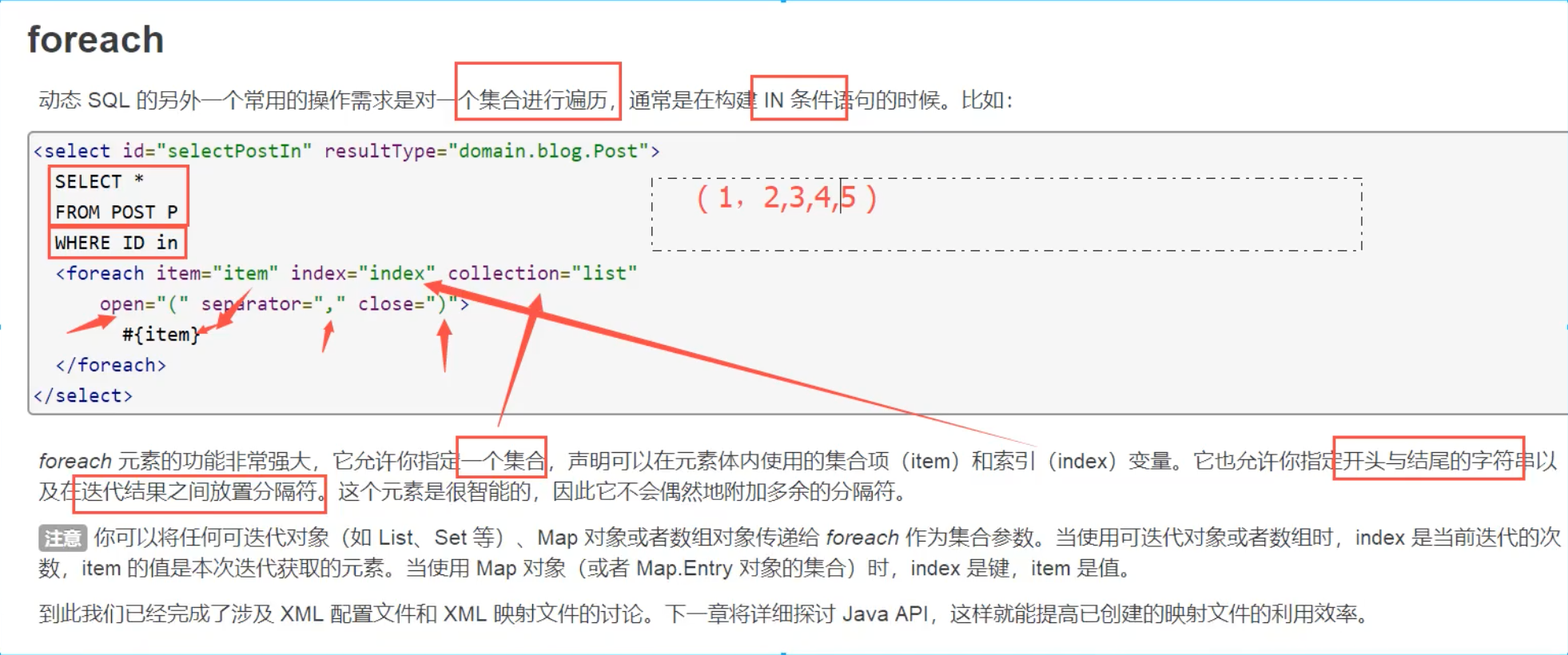

接口
//查询第1,2,3好记录的博客
List<Blog> queryBlogForEach(Map map);foreach
<!--
select * from mybatis.blog where 1=1 and (id=1 or id=2 or id=3)
我们现在传递一个万能的map,这map中可以存在一个集合!
-->
<select id="queryBlogForEach" parameterType="map" resultType="blog">
select * from mybatis.blog
<where>
<foreach collection="ids" item="id" open="and (" close=")" separator="or">
id =#{id}
</foreach>
</where>
</select>
</mapper>测试
动态SQL就是在拼接SQL语句,我们只要保证SQL的正确性,按照SQL的格式,去排列组合就可以了
建议:
-
先在Mysql中写出完整的SQL,在对应的去修改成为我们的动态SQL实现通用即可!
13、缓存
13.1、简介
1.什么是缓存[Cache]?
查询 : 连接数据库,耗资源
一次查询的结果,给他暂存一个可以直接取到的地方 --> 内存:缓存
我们再次查询的相同数据的时候,直接走缓存,不走数据库了
-
存在内存中的临时数据
-
将用户经常查询的数据放在缓存(内存)中,用户去查询数据就不用从磁盘上(关系型数据库文件)查询,从缓存中查询,从而提高查询效率,解决了高并发系统的性能问题
2.为什么使用缓存?
-
减少和数据库的交互次数,减少系统开销,提高系统效率
3.什么样的数据可以使用缓存?
-
经常查询并且不经常改变的数据 【可以使用缓存】
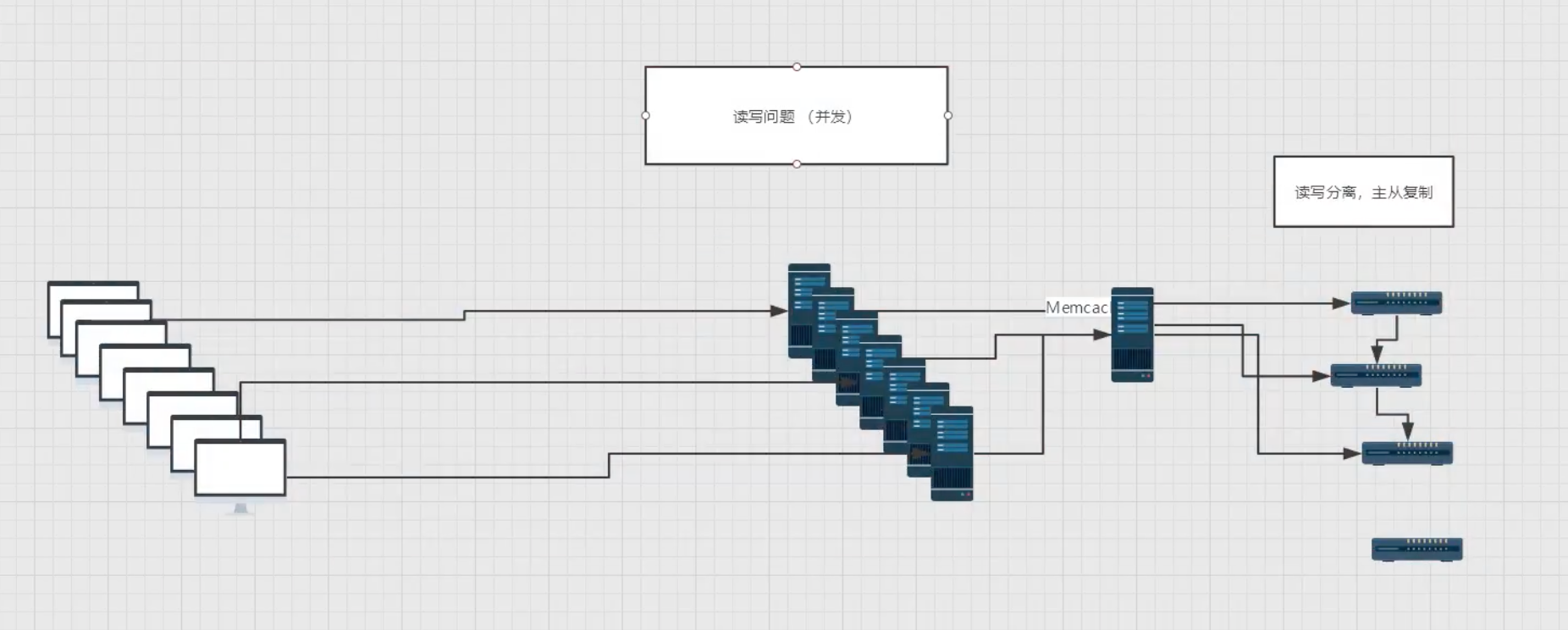
13.2 MyBatis缓存
-
MyBatis包含一个非常强大的查询缓存特性,它可以非常方便的定制和配置缓存,缓存可以极大的提高查询效率。
-
MyBatis系统中默认定义了两级缓存:一级缓存和二级缓存
-
默认情况下,只有一级缓存开启(SqlSession级别的缓存,也称为本地缓存)
-
二级缓存需要手动开启和配置,他是基于namespace级别的缓存。
-
为了提高可扩展性,MyBatis定义了缓存接口Cache。我们可以通过实现Cache接口来定义二级缓存。
-
13.3 一级缓存
-
一级缓存也叫本地缓存:SqlSession
-
与数据库同一次会话期间查询到的数据会放在本地缓存中
-
以后如果需要获取相同的数据,直接从缓存中拿,没必要再去查询数据库
-
测试步骤:
1.开启日志
2.测试在一个Session中查询两次记录
//根据id查询用户
User getUserById(@Param("id") int id); <select id="getUserById" resultType="user">
select * from mybatis.user where id = #{id};
</select> @Test
public void test(){
SqlSession sqlSession = MybatisUtils.getSqlSession();
UserMapper mapper = sqlSession.getMapper(UserMapper.class);
User userById = mapper.getUserById(2);
System.out.println(userById);
System.out.println("===================");
User userById2 = mapper.getUserById(2);
System.out.println(userById2);
sqlSession.close();
}3.查看日志输出
缓存失效的情况:
1.查询不同的东西
2.增删改操作,可能会改变原来的数据,所以必定会刷新缓存
3.查询不同的Mapper.xml
4.手动清理缓存
小结:一级缓存默认是开启的,只在一次sqlsession中有效,也就是拿到连接到关闭连接这个区间段!
一级缓存就是一个Map!
13.4 二级缓存
-
二级缓存也叫全局缓存,一级缓存作用域太低了,所以诞生了二级缓存
-
基于namespace级别的缓存,一个名称空间,对应一个二级缓存
-
工作机制
-
一个会话查询一条数据,这个数据就会被放在当前会话的一级缓存中
-
如果会话关闭了,这个缓存对应的一级缓存就没了;但是我们想要的是,会话关闭了,一级缓存中的数据被保存到二级缓存中
-
新的会话查询信息,就可以从二级缓存中获取内容
-
不同的mapper查询出的数据会放在自己对应的缓存(map)中
-
一级缓存开启(SqlSession级别的缓存,也称为本地缓存)
-
二级缓存需要手动开启和配置,他是基于namespace级别的缓存。
-
为了提高可扩展性,MyBatis定义了缓存接口Cache。我们可以通过实现Cache接口来定义二级缓存。
步骤:
1.开启全局缓存
<!--显示的开启全局缓存-->
<setting name="cacheEnabled" value="true"/>2.在Mapper.xml中使用缓存
<!--在当前Mapper.xml中使用二级缓存-->
<cache/>也可以自定义参数
<!--在当前Mapper.xml中使用二级缓存-->
<cache
eviction="FIFO"
flushInterval="60000"
size="512"
readOnly="true"/>3.测试
1.问题:我们需要将实体类序列化,否则就会报错:
Caused by: java.io.NotSerializableException: com.kuang.pojo.User序列化:
@Data
public class User implements Serializable {
private int id;
private String name;
private String pwd;
}小结:
-
只要开启了二级缓存,在同一个Mapper下就有效
-
所有的数据都会放在一级缓存中
-
只有当前会话提交,或者关闭的时候,才会提交到二级缓存中
13.5 缓存原理
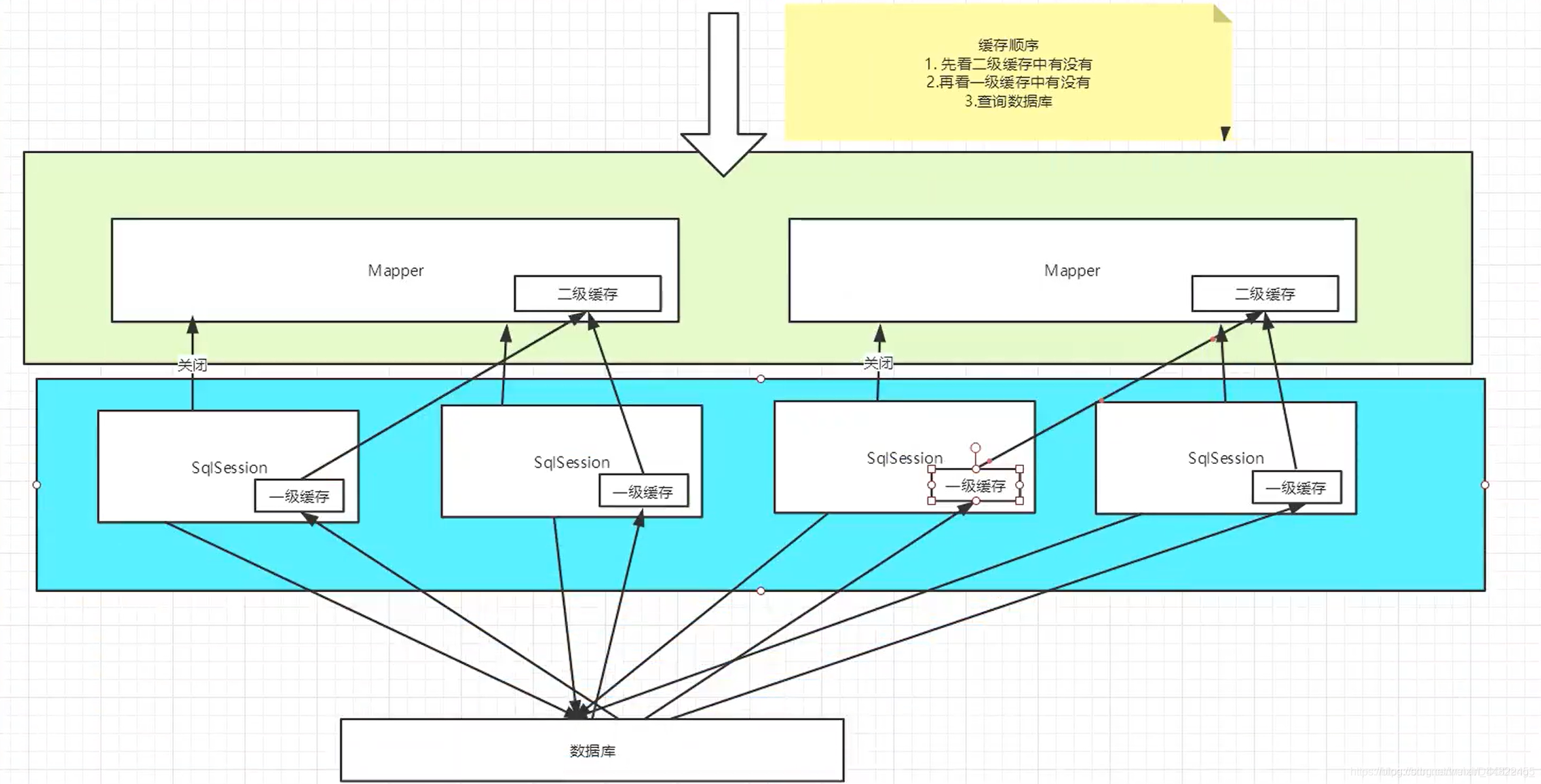
注意:
-
只有查询才有缓存,根据数据是否需要缓存(修改是否频繁选择是否开启)useCache=“true”
<select id="getUserById" resultType="user" useCache="true">
select * from user where id = #{id}
</select>
13.6 自定义缓存-ehcache
Ehcache是一种广泛使用的开源Java分布式缓存。主要面向通用缓存
要在程序中使用ehcache,先要导包!
<!-- https://mvnrepository.com/artifact/org.mybatis.caches/mybatis-ehcache -->
<dependency>
<groupId>org.mybatis.caches</groupId>
<artifactId>mybatis-ehcache</artifactId>
<version>1.2.2</version>
</dependency>
2.在mapper中指定使用我们的ehcache缓存实现
<cache type="org.mybatis.caches.ehcache.EhcacheCache"/>
ehcache.xml
<?xml version="1.0" encoding="UTF-8"?>
<ehcache xmlns:xsi="http://www.w3.org/2001/XMLSchema-instance"
xsi:noNamespaceSchemaLocation="http://ehcache.org/ehcache.xsd"
updateCheck="false">
<diskStore path="./tmpdir/Tmp_EhCache"/>
<defaultCache
eternal="false"
maxElementsInMemory="10000"
overflowToDisk="false"
diskPersistent="false"
timeToIdleSeconds="1800"
timeToLiveSeconds="259200"
memoryStoreEvictionPolicy="LRU"/>
<cache
name="cloud_user"
eternal="false"
maxElementsInMemory="5000"
overflowToDisk="false"
diskPersistent="false"
timeToIdleSeconds="1800"
timeToLiveSeconds="1800"
memoryStoreEvictionPolicy="LRU"/>
</ehcache>
<!--
defaultCache:默认缓存策略,当ehcache找不到定 义的缓存时,则使用这个缓存策略。只能定义个。
-->
<!--
name;缓仔名称。
maxE7 ementsInMemory:级存最大数目
maxEl ementsonDisk:硬盘最大级存个数。
eternal:对象是否水久有效,但设置 了,timeout将 不起作用。
overflowToDisk:是否保存到磁盘,当系统当机时
timeToIpleseconds:设置对象在失效前的允许闲置时间(单位:秒)。仅"eternal=false对象不是水
久有效时使用,可选属性,默认值是0,也就是可闲置时间无穷 大。
timeToLiveseconds:设置对象在失效前允许存活时间(单位:秒)。最大时间介于创建时间和失效时间之
间。仅当eterna1=false对象不是永久有效时使用,默认是0.,也就是对象存活时间无穷大。
diskPersistent:是否缓存虚拟机重启期数据whether the disk store persists between
restarts of the virtua7 Machine. The default value is false.
di skSpoolBuffersizeMB:这个参数设置Diskstore (磁盘缓存)的缓存区大小。默认是30MB。每个
Cache都应该有自己的一个缓冲区。
diskExpi ryThreadIntervalseconds:磁盘失效线程运行时间间隔,默认是120秒。
memorystoreEvictionPolicy:当达imaxElements InMemory限制时。Ehcache将 会根据指定的策略
去清理内存。默认策略是LRU (最近最少使用)。你可以设置为FIFO (先进先出)或是LFU (较少使用)。
clearonFlush:内存数量最大时是否清除。
memorystoreEvictionPolicy:可选策略有: LRU (最近最少使用,默认策略)、FIFO (先进先出)、
FIFO, first in first out. 这个是大家最熟的,先进先出。
LFU, Less Frequently used,就是上面例子中使用的策略,直白一点就是讲一直以来最少 被使用的。
如士面所讲,缓存的元素有一个hit属性,hit值最小的将会被清出缓存。
LRU. Least Recently Used,最近最少使用的,缓存的元素有一个时间戳,当缓存容量满了,而又需要
腾出地方来缓存新的元素的时候,那么现有缓存元素中时问戳离当前时间最远的元素将被清出缓存。
一一>
Redis数据库来做缓存! K-V





【推荐】国内首个AI IDE,深度理解中文开发场景,立即下载体验Trae
【推荐】编程新体验,更懂你的AI,立即体验豆包MarsCode编程助手
【推荐】抖音旗下AI助手豆包,你的智能百科全书,全免费不限次数
【推荐】轻量又高性能的 SSH 工具 IShell:AI 加持,快人一步
· 被坑几百块钱后,我竟然真的恢复了删除的微信聊天记录!
· 【自荐】一款简洁、开源的在线白板工具 Drawnix
· 没有Manus邀请码?试试免邀请码的MGX或者开源的OpenManus吧
· 园子的第一款AI主题卫衣上架——"HELLO! HOW CAN I ASSIST YOU TODAY
· 无需6万激活码!GitHub神秘组织3小时极速复刻Manus,手把手教你使用OpenManus搭建本